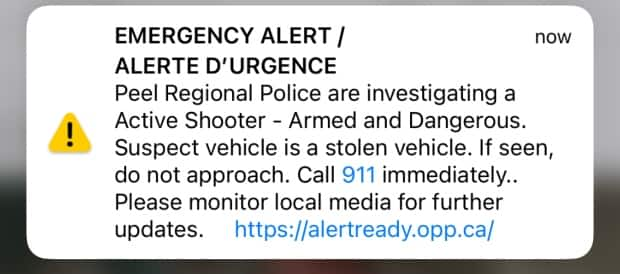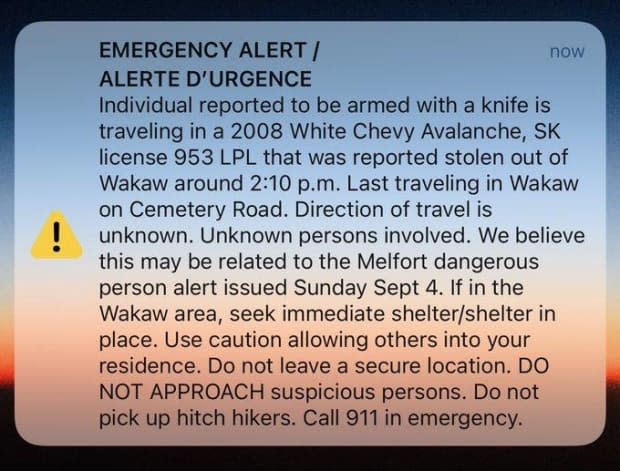Safety alert gave public no 'actionable' information during GTA shooting rampage, critics say

A killer was on the loose and two people were dead, including a Toronto police officer and a beloved auto repair shop owner in Milton, Ont. That was the situation on Monday afternoon when a public emergency alert went out saying Peel police were investigating an active shooter in the region.
The only other information that appeared on cell phone screens in the Greater Toronto Area was that the suspect was armed and dangerous and travelling in a stolen vehicle. There was no word on the make and model of that vehicle and no suspect description.
While the alert included a link to more information, the on-screen message simply directed the public to monitor local media.
These alerts often go ignored because they don't immediately provide vital information that would give the public a role in helping investigators, says Terry Flynn, a professor of communications management at Hamilton's McMaster University who has studied Canada's National Public Alerting System.
"The incident ended in Hamilton. I have a young student who lives in that area. She knew nothing about it," said Flynn.
The active shooter alert also came at 4:23 p.m, more two hours after Const. Andrew Hong was shot and killed in a Tim Hortons in Mississauga. Meanwhile, Peel Regional Police did not say when they decided to issue the alert on Monday or who within their ranks ultimately makes that decision.
Minutes after the alert was issued, Halton Regional Police said in a tweet they had taken the shooter into custody. The public would later learn the suspect had died and there was no longer a public threat.
Monday's alert needed to include more information, says expert
Flynn says emergency alerts can play a crucial role in advising people of an active emergency, but are only effective when they give the public an idea on how to respond.
"My one thought about this specific incident is that it didn't give us actionable statements," said Flynn.

"A stolen car — how do I differentiate that from every other car that's on the road?"
Flynn adds most of his students saw the alert, but ignored it and were not following local news.
Canada's Alert Ready system was introduced in 2015. In Ontario, alerts are administered through Ontario's provincial police force.
Most alerts are put out to warn the public of natural disasters. According to Alert Ready, 158 of the 169 alerts issued in Ontario this year have been for tornadoes.
Seldom are they used for civil emergencies such as an active shooter. Regional police agencies must submit a request and Ontario Provincial Police must grant that request and put the alert out in the applicable region.
Jacob Westfall, chief technology officer with Public Emergency Alerting Services Inc., says this can sometimes slow things down.
"It can certainly take some time, that whole process," said Westfall.
System for getting alerts to public varies by province
Westfall says some police forces in other provinces have direct access to the platforms that send out emergency alerts.
"Other regions in the country, certainly on the western side, have a little bit more experience with public alert systems than other regions," he said.
Recently, alerts were used by the RCMP to aid their search for Myles and Damien Sanderson, the brothers who killed 10 people in a stabbing rampage in Saskatchewan earlier this month.
In that case, police included information about the suspects' vehicle.

However, critics have had a lot to say about the role of alerts — or lack thereof — in the Nova Scotia massacre.
At the time of the shootings that killed 22 people on April 18 and 19, 2020, all Nova Scotia police agencies had to send a request for an alert and the accompanying text to the provincial Emergency Management Office.
Documents released by the public inquiry into the shootings show that an active shooter situation did not meet the criteria for sending an emergency alert two years ago.
Furthermore, the RCMP had turned down the ability to directly issue emergency alerts multiple times in the years before the tragedy.
Westfall says this is the first time Peel police have issued an active shooter alert. He adds there have been a few active shooter alerts in Ontario in the last year, primarily in the north.
"We certainly haven't seen many active shooter alerts in Ontario," he told CBC Toronto
"It's fairly new that the OPP has started to make that available to police officers and police agencies in Ontario."


